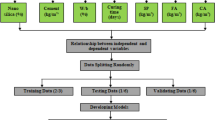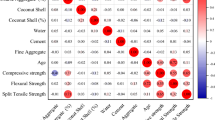Abstract
This study investigates the mechanical properties of high-strength self-compacting concrete (HSSCC) through rigorous laboratory testing. Six input parameters—cement, water-cement ratio, nano-silica percentage, fine aggregate, coarse aggregate and temperature—are analysed with compressive, flexural, and split tensile strengths. The study explores the impact of elevated temperatures (100–800 °C) on high-strength self-compacting concrete (HSSCC). Results demonstrate a consistent decline in mechanical strengths, with nano-silica notably enhancing compressive strength, particularly at a water-to-cement (w/c) ratio of 0.30. Elevated nano-silica counters the decrease in flexural and split tensile strengths with rising temperatures. Mass loss shows a pronounced escalation between 400 and 800 °C, underscoring the importance of nano-silica for optimizing durability in diverse temperature conditions. A dataset of 135 data points is used to develop machine learning prediction models employing six algorithms. The hybrid model of XGBoost with Whale Optimization Algorithm (WOA) Regression emerges as the most accurate predictor, demonstrating strong generalizability. The chosen model exhibits exceptional predictive performance, as evidenced by high R2 values of 0.981 for compressive strength, 0.9842 for flexural strength, and 0.9898 for split tensile strength. Moreover, the model demonstrates precision with low errors, including standard deviations of 6.2, 2.1, and 3.2, and minimal mean squared errors, mean absolute errors, and mean absolute percentage errors. The Taylor diagram visually assesses model performance, with the hybrid model outperforming other models. This research contributes insights into optimising concrete strength prediction and provides a foundation for further exploration into additional influencing factors and admixtures.














Similar content being viewed by others
Availability of data, material, and code
Some or all data, models, or codes generated or used during the study are available from the corresponding author by request.
References
Massana J, Reyes E, Bernal J et al (2018) Influence of nano- and micro-silica additions on the durability of a high-performance self-compacting concrete. Constr Build Mater 165:93–103. https://doi.org/10.1016/j.conbuildmat.2017.12.100
Hani N, Nawawy O, Ragab KS, Kohail M (2018) The effect of different water/binder ratio and nano-silica dosage on the fresh and hardened properties of self-compacting concrete. Constr Build Mater 165:504–513. https://doi.org/10.1016/j.conbuildmat.2018.01.045
Adesina A (2020) Recent advances in the concrete industry to reduce its carbon dioxide emissions. Environ Challeng 1:100004. https://doi.org/10.1016/j.envc.2020.100004
Jalal M, Mansouri E, Sharifipour M, Pouladkhan AR (2012) Mechanical, rheological, durability and microstructural properties of high performance self-compacting concrete containing SiO2 micro and nanoparticles. Mater Des 34:389–400. https://doi.org/10.1016/j.matdes.2011.08.037
Diptikanta Rout MK, Biswas S, Shubham K, Sinha AK (2023) A systematic review on performance of reclaimed asphalt pavement (RAP) as sustainable material in rigid pavement construction: current status to future perspective. J Build Eng 76:107253. https://doi.org/10.1016/j.jobe.2023.107253
Deilami S, Aslani F, Elchalakani M (2019) An experimental study on the durability and strength of SCC incorporating FA, GGBS and MS. Proc Inst Civil Eng Struct Build 172:327–339. https://doi.org/10.1680/jstbu.17.00129
Faraj RH, Hama Ali HF, Sherwani AFH et al (2020) Use of recycled plastic in self-compacting concrete: a comprehensive review on fresh and mechanical properties. J Build Eng 30:101283. https://doi.org/10.1016/j.jobe.2020.101283
Meko B, Ighalo JO, Ofuyatan OM (2021) Enhancement of self-compactability of fresh self-compacting concrete: a review. Clean Mater 1:100019. https://doi.org/10.1016/j.clema.2021.100019
Seifan M, Mendoza S, Berenjian A (2020) Mechanical properties and durability performance of fly ash based mortar containing nano- and micro-silica additives. Constr Build Mater 252:119121. https://doi.org/10.1016/j.conbuildmat.2020.119121
Shahbazpanahi S, Faraj RH (2020) Feasibility study on the use of shell sunflower ash and shell pumpkin ash as supplementary cementitious materials in concrete. J Build Eng 30:101271. https://doi.org/10.1016/j.jobe.2020.101271
Al Ghabban A, Al Zubaidi AB, Jafar M, Fakhri Z (2018) Effect of nano SiO2 and nano CaCO3 on the mechanical properties, durability and flowability of concrete. IOP Conf Ser Mater Sci Eng 454:012016. https://doi.org/10.1088/1757-899X/454/1/012016
Niewiadomski P, Hoła J (2020) Failure process of compressed self-compacting concrete modified with nanoparticles assessed by acoustic emission method. Autom Constr 112:103111. https://doi.org/10.1016/j.autcon.2020.103111
Faez A, Sayari A, Manie S (2020) Mechanical and rheological properties of self-compacting concrete containing Al2O3 nanoparticles and silica fume. Iran J Sci Technol Transact Civil Eng 44:217–227. https://doi.org/10.1007/s40996-019-00339-y
Niewiadomski P, Hoła J, Ćwirzeń A (2018) Study on properties of self-compacting concrete modified with nanoparticles. Arch Civil Mech Eng 18:877–886. https://doi.org/10.1016/j.acme.2018.01.006
Nazari A, Riahi S (2011) Retracted: TiO2 nanoparticles effects on physical, thermal and mechanical properties of self compacting concrete with ground granulated blast furnace slag as binder. Energy Build 43:995–1002. https://doi.org/10.1016/j.enbuild.2010.12.025
Niewiadomski P, Stefaniuk D (2020) Creep assessment of the cement matrix of self-compacting concrete modified with the addition of nanoparticles using the indentation method. Appl Sci 10:2442. https://doi.org/10.3390/app10072442
Madandoust R, Mohseni E, Mousavi SY, Namnevis M (2015) Retracted: an experimental investigation on the durability of self-compacting mortar containing nano-SiO2, nano-Fe2O3 and nano-CuO. Constr Build Mater 86:44–50. https://doi.org/10.1016/j.conbuildmat.2015.03.100
Naseri F, Jafari F, Mohseni E et al (2017) Experimental observations and SVM-based prediction of properties of polypropylene fibres reinforced self-compacting composites incorporating nano-CuO. Constr Build Mater 143:589–598. https://doi.org/10.1016/j.conbuildmat.2017.03.124
Khoshakhlagh A, Nazari A, Khalaj G (2012) Effects of Fe2O3 Nanoparticles on water permeability and strength assessments of high strength self-compacting concrete. J Mater Sci Technol 28:73–82. https://doi.org/10.1016/S1005-0302(12)60026-7
Alani NY, Al-Jumaily IA, Hilal N (2021) Effect of nanoclay and burnt limestone powder on fresh and hardened properties of self-compacting concrete. Nanotechnol Environ Eng 6:20. https://doi.org/10.1007/s41204-021-00114-3
Hosseini P, Afshar A, Vafaei B et al (2017) Effects of nano-clay particles on the short-term properties of self-compacting concrete. Eur J Environ Civ Eng 21:127–147. https://doi.org/10.1080/19648189.2015.1096308
Khotbehsara MM, Miyandehi BM, Naseri F et al (2018) Effect of SnO2, ZrO2, and CaCO3 nanoparticles on water transport and durability properties of self-compacting mortar containing fly ash: Experimental observations and ANFIS predictions. Constr Build Mater 158:823–834. https://doi.org/10.1016/j.conbuildmat.2017.10.067
Kadhim AS, Atiyah AA, Salih SA (2020) Properties of self-compacting mortar containing nano cement kiln dust. Mater Today Proc 20:499–504. https://doi.org/10.1016/j.matpr.2019.09.177
Hamdy GA, Ahmed HEH, Barakat AYY, Mostafa MA (2019) Experimental investigation of self-compacting concrete beams with nano materials additives. Intellekt Sist Proizv 17:20. https://doi.org/10.22213/2410-9304-2019-3-20-32
Nazari A, Riahi S (2011) Retracted Article: effects of CuO nanoparticles on compressive strength of self-compacting concrete. Sādhanā 36:371. https://doi.org/10.1007/s12046-011-0023-7
Mohammedameen A (2022) Performance of alkali-activated self-compacting concrete with incorporation of nanosilica and metakaolin. Sustainability 14:6572. https://doi.org/10.3390/su14116572
Mostafa SA, Tayeh BA, Almeshal I (2022) Investigation the properties of sustainable ultra-high-performance basalt fibre self-compacting concrete incorporating nano agricultural waste under normal and elevated temperatures. Case Stud Construct Mater 17:e01453. https://doi.org/10.1016/j.cscm.2022.e01453
Faraj RH, Mohammed AA, Omer KM (2023) Synergistic effects of recycled plastic aggregate and nano-silica on the elevated temperature and durability performance of self-compacting concrete. J Build Eng 75:106986. https://doi.org/10.1016/j.jobe.2023.106986
Hussien RM, Abdel-Hafez LM, Mohamed RAS et al (2022) Influence of nano waste materials on the mechanical properties, microstructure, and corrosion resistance of self-compacted concrete. Case Stud Construct Mater 16:e00859. https://doi.org/10.1016/j.cscm.2021.e00859
Ashwini K, Srinivasa RP (2021) Effect of elevated temperature on strength and durability properties of concrete using nano-silica and alccofine. Res Eng Struct Mater. https://doi.org/10.17515/resm2021.281st0419
Stel’makh SA, Shcherban EM, Beskopylny A et al (2022) Development of high-tech self-compacting concrete mixtures based on nano-modifiers of various types. Materials 15:2739. https://doi.org/10.3390/ma15082739
Vinod Kumar G, Narendra Kumar B (2022) Effect on mechanical, durability and micro structural properties of high strength self compacting concrete with inclusion of micro and nano silica. Mater Today Proc 60:569–575. https://doi.org/10.1016/j.matpr.2022.02.064
Gogineni A, Rout MKD, Shubham K (2023) Prediction of compressive strength of glass fiber-reinforced self-compacting concrete interpretable by machine learning algorithms. Asian J Civil Eng. https://doi.org/10.1007/s42107-023-00891-z
Gogineni A, Rout MKD, Shubham K (2023) Evaluating machine learning algorithms for predicting compressive strength of concrete with mineral admixture using long short-term memory (LSTM) Technique. Asian J Civil Eng. https://doi.org/10.1007/s42107-023-00885-x
Khan K, Iqbal M, Jalal FE et al (2022) Hybrid ANN models for durability of GFRP rebars in alkaline concrete environment using three swarm-based optimization algorithms. Constr Build Mater 352:128862. https://doi.org/10.1016/j.conbuildmat.2022.128862
Shubham K, Metya S, Sinha AK (2023) Surrogate model-based prediction of settlement in foundation over cavity for reliability analysis. Transp Infrastruct Geotechnol. https://doi.org/10.1007/s40515-023-00329-8
Shubham K, Rout MKD, Sinha AK (2023) Efficient compressive strength prediction of concrete incorporating industrial wastes using deep neural network. Asian J Civil Eng 24:3473–3490. https://doi.org/10.1007/s42107-023-00726-x
Rout MKD, Shubham K, Biswas S et al (2024) An integrated evaluation of waste materials containing recycled asphalt fine aggregates using central composite design. Asian J Civ Eng 25:1007–1025. https://doi.org/10.1007/s42107-023-00828-6
Aditto FS, Sobuz MdHR, Saha A et al (2023) Fresh, mechanical and microstructural behaviour of high-strength self-compacting concrete using supplementary cementitious materials. Case Stud Construct Mater 19:e02395. https://doi.org/10.1016/j.cscm.2023.e02395
Du G, Bu L, Hou Q et al (2021) Prediction of the compressive strength of high-performance self-compacting concrete by an ultrasonic-rebound method based on a GA-BP neural network. PLoS One 16:e0250795. https://doi.org/10.1371/journal.pone.0250795
Mai H-VT, Nguyen MH, Ly H-B (2023) Development of machine learning methods to predict the compressive strength of fiber-reinforced self-compacting concrete and sensitivity analysis. Constr Build Mater 367:130339. https://doi.org/10.1016/j.conbuildmat.2023.130339
Nguyen TT, Pham Duy H, Pham Thanh T, Vu HH (2020) Compressive strength evaluation of fiber-reinforced high-strength self-compacting concrete with artificial intelligence. Adv Civil Eng 2020:1–12. https://doi.org/10.1155/2020/3012139
Biswas R, Kumar M, Singh RK et al (2023) A novel integrated approach of RUNge Kutta optimizer and ANN for estimating compressive strength of self-compacting concrete. Case Stud Construct Mater 18:e02163. https://doi.org/10.1016/j.cscm.2023.e02163
Ge D-M, Zhao L-C, Esmaeili-Falak M (2023) Estimation of rapid chloride permeability of SCC using hyperparameters optimized random forest models. J Sustain Cem Based Mater 12:542–560. https://doi.org/10.1080/21650373.2022.2093291
Hameed MM, Mohd Razali SF, Wan Mohtar WHM, Yaseen ZM (2023) Improving multi-month hydrological drought forecasting in a tropical region using hybridized extreme learning machine model with Beluga Whale Optimization algorithm. Stoch Env Res Risk Assess 37:4963–4989. https://doi.org/10.1007/s00477-023-02548-4
Sufyan MS, Samui P, Mishra SS (2023) Reliability analysis of portal frame subjected to varied lateral loads using machine learning. Asian J Civil Eng. https://doi.org/10.1007/s42107-023-00893-x
Roy C, Mohanty T, Kumar Bera D (2023) Effectiveness of nano silica on properties of self-compacting concrete. Mater Today Proc. https://doi.org/10.1016/j.matpr.2023.07.273
Zende AA, Momin AA, Khadiranaikar RB et al (2023) Mechanical properties of high-strength self-compacting concrete. ACS Omega 8:18000–18008. https://doi.org/10.1021/acsomega.3c01204
Reddya AN (2019) An experimental study on effect of Colloidal Nano-Silica on tetranary blended concrete. Adv Conc Construct 7:107–115. https://doi.org/10.12989/acc.2019.7.2.107
Ruben S, Sophia M, Raja MA, Masi C (2022) Effect of elevated temperature on the properties of self-compacting mortar containing nanomaterials and zircon sand. Adv Civil Eng 2022:1–18. https://doi.org/10.1155/2022/7918750
Funding
No funding was received for conducting this study.
Author information
Authors and Affiliations
Contributions
MFA: writing, original draft. KS: data analysis, model development SK: conceptualization, editing and supervision. AKLS: reviewing and supervision.
Corresponding author
Ethics declarations
Conflict of interest
No potential conflict of interest in the subject matter discussed in this manuscript.
Additional information
Publisher's Note
Springer Nature remains neutral with regard to jurisdictional claims in published maps and institutional affiliations.
Rights and permissions
Springer Nature or its licensor (e.g. a society or other partner) holds exclusive rights to this article under a publishing agreement with the author(s) or other rightsholder(s); author self-archiving of the accepted manuscript version of this article is solely governed by the terms of such publishing agreement and applicable law.
About this article
Cite this article
Alam, M.F., Shubham, K., Kumar, S. et al. Enhancing high-strength self-compacting concrete properties through Nano-silica: analysis and prediction of mechanical strengths. J Build Rehabil 9, 43 (2024). https://doi.org/10.1007/s41024-024-00386-7
Received:
Revised:
Accepted:
Published:
DOI: https://doi.org/10.1007/s41024-024-00386-7




